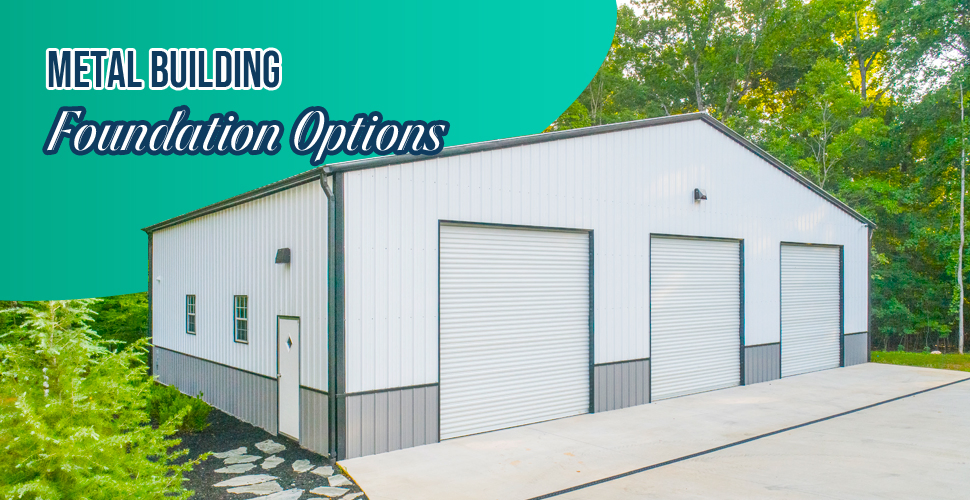
- April 11, 2024
- Metal Buildings
- Carports Advisor
Metal Building Foundation Options
“You can’t build a great building on a weak foundation.” We are sure you have heard this quote on multiple occasions. But did you know that it is also true for steel structures? That’s right. Without any ado, let’s discuss steel-building foundation options.
We will start by diving into the prerequisites for preparing the foundation for metal structures, starting with the permit. You will need a permit for:
- Construction permit
- HAVC permit
- Electrical permit
- Plumbing permit
- Fencing permit
- Deck/ pool permit
Note: The permit fee will depend on the metal building’s size and type (residential, agricultural, or commercial).
Do You Need Steel Building Permits Before Preparing Base?
To start installing a foundation, you must know the exact outline of your metal building and how much weight it is supposed to carry. If the local authority makes any structural or dimensional changes, you may end up re-building your base from scratch.
That’s why it is highly recommended that any construction work be begun after securing the permit. To get a permit, you can go to your county or city website and fill out the form with your property details, construction type, steel building blueprint, and permit fee. It generally takes up to 2 months to get a permit.
Once you get the permit, you can start with site prep and order your steel structure from the metal dealer.
What Kind Of Foundation Does A Steel Building Need?
Almost all metal structures require a concrete base as a foundation. However, some agricultural buildings and carports may not need a concrete slab. The type of foundation depends on the following factors:
- Intend of use
- Location
- Size of metal building
How To Prepare Site For Steel Building Construction?
Step 1: Clean
First, obstacles like vegetation, plantations, rocks, boulders, and large trees should be removed from the site. Before you remove any tree, contact the local municipal; if you remove any tree protected under the law, you may end up paying a fine.
Step 2: Survey
Once cleaned, you can ask the site inspector to take a site survey, grade the soil, and recommend its bearing capacity. This will save you from any future surprises. Know your local frost lines and ensure that the footing is below the frost line to prevent any shifting.
Step 3: Plan
Have an engineer design a site plan depicting the steel structure, existing building, position and orientation of the steel structure to be installed, roads, sidewalks, landscaping, setbacks, and water supply lines.
Step 4: Soil Fill & Compaction
Once the engineers’ plan and building are approved, the excavation starts. Additional filing may be required to raise the soil’s level and ensure proper drainage. The filing must then be compacted with a mechanical compactor such as a plate compactor, roller, hoe, or rammer. For a small area, you can use a hand tamp.
Step 5: Install Utilities
Soil compaction helps reduce air and moisture, creating a dense and strong base for concrete mix. It also prevents settlements and other issues in the future. At this point, you can install utility lines for water, power, and gas. However, you will need an additional permit to carry out the installation of utility lines. Let’s see a quick recap.
What Are Some Steel Building Site Prep Tips?
1. Get a permit for steel building installation, site preps, utility lines, fencing, and any other work.
2. Select a location with enough space for metal building installation, setbacks, and extra space in case you wish to expand in the future.
3. Have your site clean and leveled.
4. Mark all utility lines running beneath your installation site.
5. If you want an electric or water supply, install utility lines before pouring concrete.
6. It usually takes 2 months for site prep to finish.
7. Finally, pour the concrete base and let it cure.
Note: Wondering who’s responsible for foundation designing? A licensed structural engineer is responsible for foundation design. So, you must on-board them for your new metal project.
Steel Building Foundation On Sloped Site
For a steeper slope, a deep foundation is recommended. However, it increases the installation cost but offers more stability and strength to the metal structure. This type of foundation is generally made of the following:
- Piles
- Piers
- Caissons
These are drilled deep into the ground until they reach the rock layer. They are also quite common in areas with frequent flooding. Some foundations are actually raised above the ground, offering crawl space.
Alternatively, if the steep isn’t too deep, you can do the following:
- Excavate and cut away soil from the higher area towards the lower area, creating a balance. This will reduce soil erosion and improve drainage.
- Distance from center of footing = 2 x (width of the footing)
- Footing must be built on a leveled surface and stepped as per requirement.
What If You Don’t Do Site Preparation?
When planning a foundation for a custom metal building, you must consider site preparation as a crucial factor. An uneven ground can cause concrete to crack as it starts to set & dry. These cracks can be deep and may lead to structural failure with time.
Factors That You Must Take Into Account When Deciding Between Various Steel-Building Foundation Options
Soil Type: A soil inspector can gauge soil composition to determine whether extra filing is necessary for the building’s long-term stability. You must know the frost line before beginning installation.
Structural Load: The foundation must be able to bear the load of the entire structure along with its interior components. In addition, if you live in an area prone to extreme weather, the base must be able to bear wind, snow, and seismic loads.
Size Of Metal Building: A 4-6 inches thick concrete slab is suitable for smaller metal buildings, but for large structures, an 8-12 inches slab would be suitable. Ask your contractor about what thickness slab you should go for.
Future Expansion: If you are planning to expand, consider the additional weight of the frame and sheets. If you wish to expand in the future, opt to pour a larger foundation.
| Pre-Engineered Metal Buildings vs. Conventional Steel Buildings | |
| 1. Process: | |
| Components are designed in the factory. The crew only needs to assemble parts on-site. | The work is done step-by-step, from site excavation to foundation work. Each step must be completed before proceeding to the next one. |
| This leads to faster installation. | It takes longer than prefab installation. |
| 2. Design: | |
| It is simple in design, and standard components are mass-produced. It creates minimal to no wastage. | Metal buildings can have complex designs and be customized according to customer needs. Some waste may be created in the form of metal shavings. |
| 3. Cost: | |
| Prefab metal structures cost less than custom-built ones. | Customization and additional accessories add to the overall cost. |
| Prefabs are fast to install and less complicated in design, so they require less manpower, reducing labor costs. | Custom-built metal structures have more components and require more manpower, increasing labor costs. |
| 4. Material: | |
| Prefab metal buildings follow industry standards, i.e., 14-gauge steel and 26-gauge panels. | Custom steel buildings are meant to meet or exceed local building codes. They are supposed to withstand extreme weather conditions. The frame is generally 12-gauge steel, and panels can be 22 or 24-gauge. |
| They are lightweight and can cost up to 30% less. | Since these are heavier than prefab, they cost more. |
| 5. Foundation: | |
| Simple foundational work is needed because the design is simple. | Custom built requires a precision foundation design that can bear all loads without any failure. |
Types Of Metal Building Foundation
There are numerous types of foundations that you can build for a steel building. Let’s look at the most common ones.
1. Gravel Foundation For Metal Building
It is made of crushed stone, 4 to 6 inches thick. The base is raised by 2 to 4 inches to provide excellent drainage. It is the most cost-effective option, especially with a limited budget.
The only downside is that over time, gravel bases may develop trenches; hence, they need re-leveling at regular intervals. They are more durable than simply leveled ground but less durable than a concrete base. Of all steel building foundation types, gravel is mainly used for storage and shed purposes.
Note: Add grass around the perimeter to prevent soil erosion.
2. Perimeter Wall Foundation For Metal Building
A continuous concrete wall is constructed around the perimeter of the building. This is where base rails and legs are mounted. It supports the exterior of the steel building. This type of base is generally used in agricultural sectors.
Anchors are placed on this wall to support the overall structure. It is suitable for buildings that need heavy load-bearing and insulation. It gives firm support to the primary frame of any metal building.
3. Pier Foundation For Steel Building
Pier and footing bases are suitable for uneven terrain and areas with frequent flooding. You have probably seen this type of base in bridges and dams, and it is also used in the construction of taller buildings.
The pier can be made of concrete, masonry, or steel. During construction, piers are reinforced into the ground until they reach a firm rock layer, which provides structural stability and durability.
4. Slab Foundation For Steel Building
It is a flat concrete slab, generally 4 to 6 inches thick. A concrete base has the most structural load-bearing ability compared to others, which is why Carports Advisor highly recommends it. Concrete slabs are most suitable for large and heavy structures.
It is often used in industrial and commercial sectors. For construction, a thick layer of concrete mix is poured into a temporary mold over a leveled surface. This leveled surface is reinforced with steel bars that give strength & increase the lifespan of the concrete.
Then, it is left to cure for at least 28 days to gain full strength. It offers structural stability, durability, and a smooth surface. You can even layer the top with a concrete sealant.
Looking For Metal Building Quotes?
Call Carports Advisor at (336)-914-1654 and get all the details. We offer a wide range of customization, including a variety of dimensions and colors. So, don’t wait – call now!

